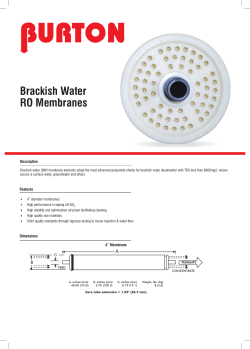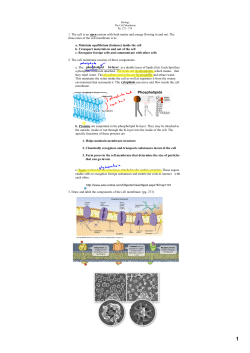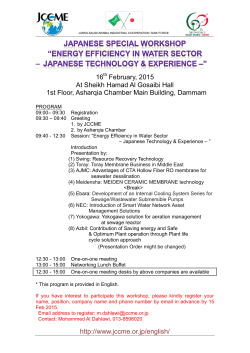
Chapter8
Chapter 8 Lipids and Proteins Are Associated in Biological Membranes 生化科 吳嘉霖老師 第一醫學大樓0859室 校內分機:5159 What is a Lipid Lipids: a heterogeneous class of naturally occurring organic compounds classified together on the basis of common solubility properties • insoluble in water, but soluble in aprotic organic solvents including diethyl ether, chloroform, methylene chloride, and acetone • Amphipathic (雙極性) in nature Lipids include: • Open Chain forms • fatty acids, triacylglycerols, sphingolipids, phosphoacylglycerols, glycolipids, • lipid-soluble vitamins(A,D,E,K) • prostaglandins, leukotrienes, and thromboxanes • Cyclic forms • cholesterol, steroid hormones, and bile acids Fatty Acids • Fatty acid: an unbranched-chain carboxylic acid, most commonly of 12 20 carbons, derived from hydrolysis of animal fats, vegetable oils, or phosphodiacylglycerols of biological membranes 親水端 疏水端 Fatty Acids Length of fatty acid plays a role in its chemical character" • Usually contain even numbers of carbons (can contain odd, depending on how they are biosynthesized)" • FA that contain C=C, are unsaturated(不飽和): If contain only C-C bonds, they are saturated(飽和) Fatty Acids • In most unsaturated fatty acids, the cis(順式) isomer predominates; the trans(反式) isomer is rare • Unsaturated fatty acids have lower melting points than their saturated counterparts; the greater the degree of unsaturation, the lower the melting point Triacylglycerols(三酸甘油脂) • Triacylglycerol (triglyceride): an ester of glycerol with three fatty acids • Triacylglycerol通常聚集在脂肪組織中,脂肪酸儲存的主要方法。 • natural soaps are prepared by boiling triglycerides (animal fats or vegetable oils) with NaOH, in a reaction called saponification (Latin, sapo, soap) Soaps ·• 生物體外用脂肪酸與鹼(如 NaOH)作用稱 saponification(皂化反應) ·• 生物體想利用脂肪酸時, Triacylglycerol會被lipases水解 • Soaps form water-insoluble salts when used in water containing Ca2+, Mg2+ (hard water)-硬水中的Ca2+, Mg2+會 和脂肪酸反應產生沈澱 Soap Phosphoacylglycerols (Phospholipids)-磷脂質 • When one alcohol group of glycerol is esterified by a phosphoric acid rather than by a carboxylic acid, phosphatidic acid(磷脂酸) produced • Phosphoacylglycerols (phosphoglycerides) are the second most abundant group of naturally occurring lipids, and they are found in plant and animal membranes(細胞膜的主要成分) Phosphoacylglycerols Waxes(蠟) • A complex mixture of esters of long-chain carboxylic acids and alcohols • Found as protective coatings for plants and animals(存在於植物的莖、葉、果實、動物毛皮、羽毛) 棕櫚蠟的主要成份 鯨魚產生的蠟 Sphingolipids(神經鞘脂質) • Contain sphingosine, a longchain amino alcohol sphingosine • Found in plants and animals • Abundant in nervous system (神經系統含量特別豐富) • Bares structural similarity to phospholipids 主要存在於神經系統之細胞膜內 Multiple sclerosis(多發性硬化症) Myelin sheath: 70 - 85% lipids and about 15 – 30% proteins Glycolipids(細胞膜上的標記) • Glycolipid: a compound in which a carbohydrate is bound to an -OH of the lipid • In most cases, sugar is either glucose or galactose • many glycolipids are derived from ceramides • Glycolipids with complex carbohydrate moiety that contains more than 3 sugars are known as gangliosides(神經苷脂類: 含三個以上醣基) 葡萄糖腦苷脂 Gangliosides(神經苷脂類:含三個以上醣基) Steroids(類固醇) • Steroids: a group of lipids that have fused-ring structure(融合環結構) of 3 six-membered rings, and 1 five-membered ring. 膽固醇 睪固酮 雌二醇 黃體激素 Sex Hormones • Androgens(雄激素): male sex hormones • synthesized in the testes • responsible for the development of male secondary sex characteristics • Testosterone • Estrogens(雌激素): female sex hormones • synthesized in the ovaries • responsible for the development of female secondary sex characteristics and control of the menstrual cycle Cholesterol(膽固醇) • The steroid of most interest in our discussion of biological membranes is cholesterol Biological Membranes • Every cell has a cell membrane (plasma membrane) • Eukaryotic cells also have membrane-enclosed organelles (nuclei, mitochondria…etc) • Molecular basis of membrane structure is in lipid component(s): • polar head groups are in contact with the aqueous environment • nonpolar tails are buried within the bilayer • the major force driving the formation of lipid bilayers is hydrophobic interaction(疏水性作用力) • the arrangement of hydrocarbon tails in the interior can be rigid (if rich in saturated fatty acids) or fluid (if rich in unsaturated fatty acids) Lipid Bilayers • The polar surface of the bilayer contains charged groups • The hydrophobic tails lie in the interior of the bilayer Effect of Double Bonds on the Conformations of Fatty Acids • Kink(扭結) in hydrocarbon chain and causes disorder in packing against other chains • This disorder causes greater fluidity in membranes with cisdouble bonds (碳=碳 雙鍵增加細胞膜流動性) Biological Membranes • Plant membranes have a higher percentage of unsaturated fatty acids than animal membranes • The presence of cholesterol is characteristic of animal rather than plant membranes • Animal membranes are less fluid (more rigid) than plant membranes(排列整密加上膽固醇的存在) • The membranes of prokaryotes, which contain no appreciable amounts of steroids, are the most fluid Cholesterol reduces Fluidity • Presence of cholesterol reduces fluidity by stabilizing extended chain conformations of hydrocarbon tails of FA (細胞膜內的膽固醇的存 在使得細胞膜變得較不 具流動性) 膽固醇本身融合環結構很 堅固,並可藉由凡得瓦力 穩定飽和脂肪酸伸展的長 直鏈排列。 Membrane Layers • Both inner and outer layers of bilayer contain mixtures of lipids • Compositions on inside and outside of lipid bilayer can be different(外層空間較大, 有較高濃度的大分子) Temperature Transition in Lipid Bilayer • 加熱會使排列規則的脂質雙層膜變得不規則 • Mobility of the lipid chains increases dramatically Q&A Membrane Proteins • Functions: transport substances across membranes; act as receptor sites, and sites of enzyme catalysis • Peripheral proteins(周邊蛋白質) • bound by electrostatic interactions • can be removed by raising the ionic strength • Integral proteins(嵌入蛋白質) • bound tightly to the interior of the membrane • can be removed by treatment with detergents or ultrasonification • removal generally denatures them Integral and Peripheral proteins Peripheral protein Certain Proteins are anchored to membrane by lipid anchors • N-myristoyl- and S-palmitoyl anchoring motifs Fluid Mosaic Model • Fluid: there is lateral motion of components in the membrane; • proteins, for example, “float” in the membrane and can move along its plane • Mosaic: components in the membrane exist side-by-side as separate entities • the structure is that of a lipid bilayer with proteins, glycolipids, and steroids such as cholesterol embedded in it • no complexes, as for example, lipid-protein complexes, are formed Fluid Mosaic Model of Membrane Structure Freezefracture(冷凍破 裂膜技術) Membrane Function: Membrane Transport • Passive transport(被動運輸) • driven by a concentration gradient(高濃度往低濃度) • simple diffusion: a molecule or ion moves through an opening (non charged molecules) • facilitated diffusion: a molecule or ion is carried across a membrane by a carrier/channel protein ex. Glucose permease • Active transport(主動運輸)-耗能 • a substance is moved against a concentration gradient(低 濃度往高濃度) • primary active transport: transport is linked to the hydrolysis of ATP or other high-energy molecule; for example, the Na+/K+ ion pump • secondary active transport: driven by H+ gradient ex. Galactoside permease Passive transport (simple diffusion) Simple diffusion: a molecule or ion moves through an opening (non charged molecules) Passive transport (facilitated diffusion) • Passive diffusion of species (uncharged) across membrane dependent on concentration, presence of carrier protein 葡萄糖通透酶 Active transport (primary active transport) 水解蛋白質上磷酸 根後,構型回復 K+ :細胞內>細胞外 Na+:細胞外>細胞內 蛋白質接上磷酸根 導致蛋白質構型改 變並可與Na+結合 ,打開離子孔洞。 Na+/K+ ion pump Active transport (secondary active transport) 細胞外高濃度H+離子 驅使乳醣(lactose)進 入細胞內 Galactoside permease(半乳醣苷滲透酶) How do member receptors work LDL在細胞內釋 出膽固醇,過度 供應膽固醇會抑制 LDL受體蛋白合成 Lipid-Soluble Vitamins • Vitamins are divided into two classes: lipid-soluble and water-soluble Vitamin A(和視覺有關) • Vitamin A (retinol) occurs only in the animal world • Extensively unsaturated hydrocarbon (β-carotene, β-胡蘿蔔素) Vitamin A • The best understood role of Vitamin A is its participation in the visual cycle in rod cells • the active molecule is retinal (vitamin A) retinal forms an imine with an -NH2 group of the protein opsin(視蛋白) to form the visual pigment called rhodopsin(視紫質) • Night Blindness(夜盲症),表現為在黑暗中或光線較弱的地方看 不清東西 Vitamin D(和鈣質吸收有關) • A group of structurally related compounds that are involved in the regulation of calcium and phosphorus metabolism • the most abundant form in the circulatory system is vitamin D3 • Rickets(佝僂病):缺乏維生素D導致骨頭變軟而變形 調節腸道 吸收鈣和磷 Vitamin E(良好的抗氧化效果) • The most active of vitamin E is α-tocopherol (α-生育醇,在大鼠中 為生殖所必須) • Vitamin E is an antioxidant(抗氧化劑),本身為一良好還原劑,可在 氧化劑與其他生物分子作用前先與之反應。亦可與細胞內自由基 (free radicals)反應並加以清除。 Vitamin K(修飾凝血酶原Prothrombin) • Vitamin K (koagulation)has an important role in the blood-clotting process • Long unsaturated hydrocarbon side consists of repeating isoprene units Vitamin K dicumarol & warfarin(抗凝血劑):維生素K的拮抗劑 Prostaglandins(前列腺素) • Prostaglandins: a family of compounds that have the 20carbon skeleton of prostanoic acid • First detected in seminal fluid…from prostate • The metabolic precursor is arachidonic acid,花生四烯酸 (20 carbon atoms: 4 double bonds) • Production of prostaglandins from arachidonic acid occurs in several steps. Prostaglandins: 控制血壓、刺激平滑肌收縮、導致發炎、 抑制血小板凝集 Aspirin、cortisone: 抑制Prostaglandins合成,可抗發炎 Arachodonic Acid and Some Prostoglandins Leukotrienes(白三烯素) • Compounds also derived from arachidonic acid • Found in white blood cells (leukocytes) • Consists of 3 conjugated double bonds • An important property is constriction of smooth muscles, especially in the lungs(刺激肺中平滑肌收縮) Leukotriene C 利用抑制Leukotrienes 合成的藥物治療氣喘 Thromboxanes (凝血素) 第三類arachidonic acid 衍生物,與血小板凝 結及平滑肌收縮有關
© Copyright 2025












